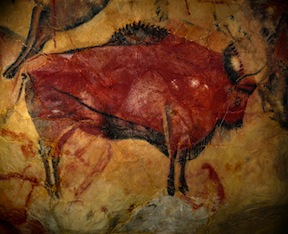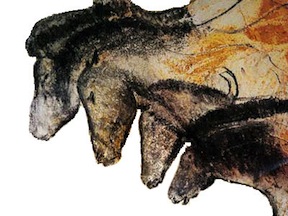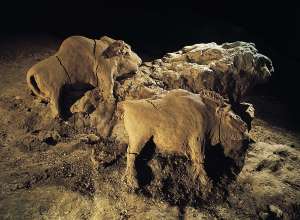I am reading some dense books: Susanne Langer in Focus (again) by Robert C. Innis, Signs and the Play of Consciousness also by Innis, and Inside the Neolithic Mind by David Lewis-Williams and David Pearce. The two by Innis are firmly in a philosophical tradition and so out of field and more difficult for me, though my knowledge of Langer helps with the first. I have just started The Neolithic Mind and find it very interesting because of its eclectic approach and their insistence that our efforts to understand our ancestors must include our understanding of our brains. Hallelujah! Innis’ Signs covers John Dewey, C. S. Pierce, Karl Buhler, and Ernst Cassirer as Innis focuses on the search for the origins of meaning in our minds. (All of these important sources for Langer’s thinking). While these philosophers are all (including Innis) deep thinkers, they do not base much of their analyses on neuroscience—granted that neuroscience in their day was a far cry from today’s, and giving Buhler credit for his grounding in biology. Of course, as I re-read Innis on Langer I come again to her biological grounding.
As I read, trying to understand more and ponder what I do comprehend, I keep returning to an observation by the great Jaak Panksepp and his imaginative speculation about the evolution of being awake and dreaming. I have mentioned this before but let me give the basics again. Deep in the brainstem are two structures that exert control on waking and dreaming. It is generally true that the lower the structure the earlier it appeared in evolution. Jaak Panksepp noticed that the dreaming center is lower than the waking center and wondered about the implication, then, that dreaming appeared before waking. His hypothesis to explain this is that when animals began to develop nervous systems the earlier lower center served an incipient consciousness. As the brain evolved in complexity and developed a wake/sleep cycle shaping diurnal activity, this higher center took over the consciousness function and the lower center became the center for REM sleep and dreaming as a holdover from its incipient consciousness function. Makes good sense.
But let me frame it just a wee bit differently. Again as I have written before, I understand the words ‘sentience’ and ‘consciousness’ to mean two different things and believe that in doing so I am parsing the phenomena more accurately than those who confuse the two terms as nearly synonomous. Or as Robert Innis might say, I am carving nature at the joints, like a good butcher should and not making artificial sections by sawing through bones. So, sentience is a basic function of all life—the sensing of what lies outside the organism—basic because all life needs to take in selectively what it needs to sustain its living. Consciousness can include sentient processing but is essentially what the organism brings to the table autonomously regardless of the external ambient and more responsive to the internal milieu and vital processes. In Langer’s terms, sentience is the organism’s response to impact from outside, i.e., its exogenic response. Consciousness is self-initiated activity, i.e., endogenic or autogenic actions derived from the ongoing matrix supporting life’s integrity. (While mostly ignored, it is important to remember that the brain is never silent nor still—it is always carrying forward vital operations, mental life and intentional behaviors.) Langer puts it another way as well: The environment determines what is given (known through sentience), the organism determines what is taken (organized through consciousness)—the parenthetical remarks are mine.
Returning even deeper into the weeds of my swamp, sentience and consciousness, being two different phases, contribute to differing mental states depending upon whether they are in an active or positive phase. In the chart below we see that when both sentient and conscious, we are fully awake. When sentient but not conscious, we are in a hypnotic state (more below). When not sentient but conscious we dream (called REM sleep), and when neither sentient nor conscious we are in deep sleep (called slow wave sleep).
S _____________________________________________________
E | +/+ | +/- |
N + | awake | hypnotic |
T | | |
I |_____________________|______________________________ |
E | -/+ | -/- |
N – | dreaming | deep sleep |
C | (REM) | (slow wave) |
E |_____________________ |______________________________|_
+ –
CONSCIOUSNESS
(sorry about the graph–it did not transfer well from my WORD program and I do not know nor have the energy to fix it–I trust you will get the idea).
Now the areas controlling awakening and dreaming that Panksepp discusses function more as switches by modulating neurotransmitters, especially the cholinergic system, flowing upwards into the midbrain and cortex. The interplay between the neurotransmitter systems, e.g., dopamine, serotonin, etc. along with hormonal systems, e.g., growth hormone, make this aspect of neural functioning a real swamp of complexity. It is not just the connectome, i.e., the connections between neurons firing away with each other, but also the chemical interplay that contributes to such a mess.
So, when I put up a matrix with 4 cells, that is for heuristic purposes only; clear and discrete functional categories are probably unicorns. Still, we are sometimes awake, asleep deeply in various stages, asleep and dreaming vigorously, and sometimes spaced out in what I have called hypnotic states. I could have used a more traditional term, ‘dissociative’, but chose not to for various reasons that are irrelevant right now. My usual example for this state is highway hypnosis—when you are driving while fatigued or stressed and find yourself 20 miles down the road or even at your destination with no memory of actively managing the trip. You must have, else you would have wrecked, so you were sentient and processing environmental contingencies to act accordingly, but you were not conscious of it.
The important thing here is that sentience and consciousness each come with varying degrees of what I will term acuity, i.e., heightened focus and broadened attention to figure and/or ground, and then the two, sentience and consciousness, interact to blend into a mostly unified experience. I bring all of this up stimulated by my current readings and remembering Panksepp’s observation about waking and dreaming. A couple of specifics from my readings before closing out this post. Innis in his books Signs and Langer emphasizes in several places that these thinkers, concerned with the incipience of significance and symbolization, kept ‘pushing the origins downward’. Signification is not the end result of higher level processing but its beginning, and it begins with perception and, given Panksepp’s notion of consciousness as an early neurological primitive of mind, arises from deep within. Langer posits that we humans are driven to symbolize and that even our earliest intuitions that arise from non-conscious processes are transformed by such symbolization.
Now consider Lewis-Williams and Pearce’s Inside the Neolithic Mind and their advocacy for a cognitive approach to archeology, one that is grounded in neuroscience. They seek to understand the experiential basis of beliefs in the supernatural, the origins of ancient cosmologies that encompassed both material and spiritual domains, and the effects of such thinking and beliefs on society and especially religious practices. And one major thrust here is that prehistoric humans entered into altered states of consciousness through a variety of means in order to explore the developing cosmology, i.e., dream world, in which the natural and supernatural worlds interacted.
Hmmm. Is that brilliant or what?
They document many ways humans have modulated their sentience/consciousness balance, i.e., entered into altered states: psychotropics, pain, sleep deprivation, intense rhythmic dancing, auditory-driving eg clapping, drumming, chanting, etc., meditation, etc. Our ancestors engaged widely through states altered to comprise different degrees of sentience and consciousness, e.g., sentiently aware of drumming and the dance, conscious of a subjectively construed spiritual domain. Those humans who had a talent for altering the balance in this way were able to assume shamanic roles more easily. Lewis-Williams and Pearce think that certain cosmological constants, i.e., features virtually universal among us, including lower, middle and upper spiritual realms as well as flying, experiencing travel through a vortex, etc., are grounded in neurological functioning. Cosmology through metaphorical thinking is thus embodied (as was demonstrated by George Lakoff and Mark Johnson in Metaphors We Live By). With this theoretical frame Lewis-Williams and Pearce go on to examine the archeological findings of Neolithic humans such as the earliest permanent settlements in the Near East and the monuments of western Europe, such as the henges and tombs, e.g., Stonehenge or Newgrange. Again, Lewis-Williams and Pearce find archeological evidence that such ‘hypnotic’ states were quite important in developing human culture.
So we dreamt before we awakened, and our dreams to this day color our waking moments. This is not just the wonderful mysticism of William Blake and other poets; it is also the paradox Panksepp confronted in the data from the evolution of neural structures: “it is remarkable how far down in the brain stem the executive mechanisms for REM sleep are situated. . . . Are we to believe that REM mechanisms are somewhat older than waking ones? However unlikely this may seem on the face of it, the above brain localizations coax us to consider such an absurdity”. I am not sure of the absurdity; Zen teaches us that the subjective-objective split is an illusion, and dreams are often a greater source of insight than waking. And then we have Blake and Yeats.
Finally, imagine this scenario from long ago: a group of apes, hominids really, gathered around a fire on a freezing cold night after ingesting a special mushroom. They cannot take their eyes from the flames flickering into the dark, entranced by the dance of shadows and light, always facing the warm flames and embers, dreaming of another time and place, they freeze their tails off. Voila! Humanity.




